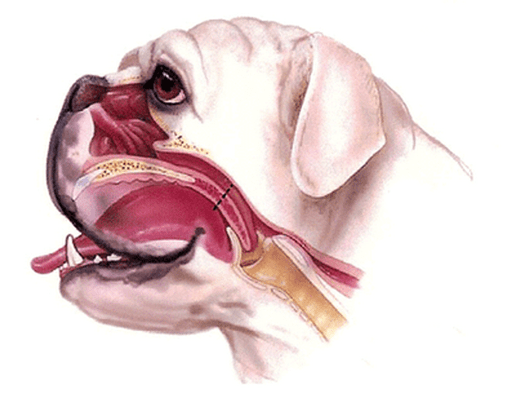Chapter 18: Table of Contents
Staphylectomy for Elongated Soft Palate
After assessing for length and determining the amount of excess tissue, a stay suture (typically 4-0 Monocryl but sometimes 3-0 Monocryl depending on patient size) is placed along the patient’s right (I am right handed) palatal edge of the soft palate (where the last tissue bite will be taking when closing). A similar suture is applied on the patient’s left palatal edge but this one is not cut and will serve as the start of the suture line. Leave the tag long so it also acts as a stay suture that you can use for traction. With traction from the two stay sutures, the soft palate is then transected using Metzembaum scissors. In a large dog, especially one with a thick palate that is more likely to bleed, I cut about half of the width across, suture the tissue edges and then cut the remaining half and suture. In small dogs, it is easier to cut the entire palate at once. Ensure not to cut your stay suture and to transect the palate evenly on both sides. Simple continuous pattern is used ensuring to appose the buccal and nasal mucosa. I try not to include the muscle as it helps to thin out the palatal edge. Ensure the suture is nice and tight (no gaping of tissues) and that your suture knots are square and not excessively large.

Diagram of elongated soft palate
(Source: https://baggybulldogs.wordpress.com/2014/11/10/soft-elongated-pallet/ )
Gauze is used to remove any hemorrhage and the endotracheal
tube is removed to assess length. If
still too long, the suture line can be cut as you remove more palatal
tissue. The goal is to get the tip of
the soft palate to be 1-2 mm shorter than the tip of the epiglottis. Cutting the palate too short can result in
nasopharyngeal reflux. Leaving it
slightly too long can result in the palate entrapping at the tip of the
epiglottis with continued obstruction.
Laser staphylectomy has been described (Clark and Sinibaldi 1994) and
represents an alternative to the hand-sewn technique (Bright and Wheaton 1983).
Appropriate laser safety guidelines must
be followed when using a laser for staphylectomy (or any other procedure). Outcomes have not been shown to differ
between hand-sewn and laser staphylectomy. (Riecks 2007) Reported advantages of laser ablation include
minimal hemorrhage, reduced swelling and possibly a sterilizing effect on the
tissues. (Riecks 2007)
References
Bright RM, Wheaton LG. A modified surgical technique for elongated soft palate in dogs. J Am Anim Hosp Assoc 1983; 9:288-292.
Clark GN, Sinibaldi KR. Use of carbon dioxide laser for treatment of elongated soft palate in dogs. J Am Vet Med Assoc 1994; 204:1779-1781.
Riecks TW, Birchard SJ, Stephens JA. Surgical correction of brachycephalic syndrome in dogs: 62 cases (1991-2004). J Am Vet Med Assoc. 2007 May 1;230(9):1324-8.
< Brachycephalic Syndrome Ventriculectomy or Sacculectomy for Everted Laryngeal Saccules>


